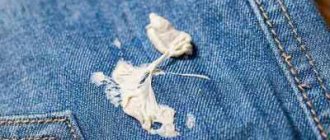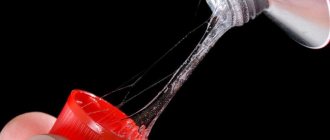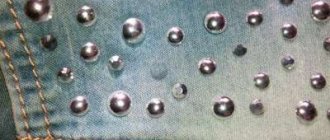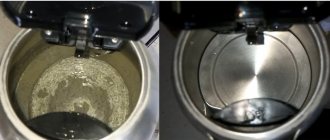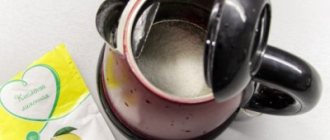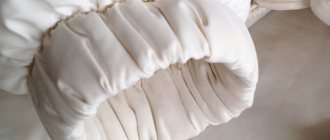Working with glue requires extreme care and precision. One careless move, and there’s a glue stain on your favorite jeans.
Many people consider such pollution to be irremovable. However, it is not. There are a sufficient number of ways to remove glue from jeans.
In this article we will tell you how and how to remove glue from jeans at home using folk remedies and household chemicals.
Important tips before removing stains on jeans
The purpose of cleaning jeans is not only to get rid of glue stains, but also to keep the item in good condition. In order to begin the glue removal procedure, it is important to know a few rules:
- You should remove glue from jeans at home as quickly as possible. The more time passes after contamination, the less chance there is of removing adhesive traces without damage.
- If there is a large amount of glue, you need to put something solid under the jeans. This will make it possible to fix a drop of solution in one place so that it does not spread across the fabric.
- Do not smear or rub the glue. This makes it impossible to remove it from the surface. The solution will only penetrate deeper into the tissue, making it more difficult to remove.
- It is impossible to remove the stain using a washing machine. The glue does not dissolve with water and washing powder. In this case, the consistency and properties of the glue are not important. Machine washing cannot remove even simple office glue.
- The use of chemicals must be tested. Most aggressive substances can damage tissue.
Cleaning should be done first on an invisible area of the fabric, for example, on the lapel of a trouser leg.
What is the insidiousness of glue
Most modern quick-setting adhesives are durable, resistant to moisture, high or low temperature.
It is also impossible to remove such stains from clothes with detergents. The glue contains cyanoacrylate, a substance that can only be dissolved using complex chemical solutions.
In everyday life, such solvents are presented in the form of acetone or certain medications.
Simple removal methods
Sometimes it is difficult to find information on how to remove superglue from jeans, so the mission seems impossible. But there are many remedies for removing glue stains at home. They are simple and accessible to every household.
Laundry soap solution
This is a universal solution for many types of stains. Not everyone knows, but laundry soap does an excellent job even of old traces of superglue. In order to remove the “second” glue from jeans, you should dissolve 2 cups of soap shavings in hot water.
The resulting solution is generously moistened on the jeans in areas of contamination and left for 15-20 minutes. After this, the remnants of the soaked glue are removed with something hard.
The water temperature in this case should be maximum - about 80 degrees
If we are talking about office glue, then you need to proceed as follows:
- Jeans are soaked in warm water for 3-3.5 hours.
- Areas with glue are treated with laundry soap. It is advisable to use a sponge or brush to remove stains more thoroughly.
- The jeans are rinsed and put into the washing machine to be washed again.
Treatment with laundry soap is carried out only when the glue has not had time to be absorbed into the fabric.
First steps with a fresh spot of glue
It is easier to remove a fresh glue stain from clothes. It has not yet penetrated the structure of the fabric, it is on the surface. It needs 1–2 hours to dry, and if we are talking about superglue, then no more than 30 minutes. The worst thing is if the substance gets on nylon or silk. These fabrics are thin, sensitive, and the glue leaves a burn on them.
First steps when adhesive gets on fabric:
- carefully remove the item so that the drops do not spread;
- place the item on a hard surface;
- Use a paper towel to carefully remove any adhesive drops;
- if the material is dense, the drops can be removed with the back of a knife blade;
- Rinse clothes thoroughly with running water.
To completely destroy adhesive traces, you need to use a stain remover or improvised means. We will talk about them further.
Removing traces of stationery and wood glue
These types of glue are very common in home use. Children often use them, which increases the chances of the solution getting on their clothes. You can wash jeans from office glue using laundry soap.
To do this, soak the newly soiled item in cool water. The damaged areas are rubbed generously with soap and left in this state for half an hour. After this, the jeans are washed as usual.
Wood glue is a little more difficult to remove. A fresh stain is rubbed with a piece of cloth soaked in alcohol. You can also use acetone. After this treatment, you should rub the jeans with laundry soap and give a little time for the reaction. At the end of the cleaning process, the item is washed and rinsed thoroughly.
First steps with a fresh stain
First, carefully remove soiled clothing.
It is important in this situation to force the glue to stay in one drop, preventing it from spreading over the surface
Next, you should quickly navigate the situation and find cardboard, thick paper, a board or plate and put it on the table.
Clothes are placed on top of such a substrate, carefully straightened in a horizontal position.
Further work depends on the type of fabric, because some types of products can have an aggressive effect on its structure. It’s good if the clothes still have labels indicating how to care for them. If they are not there, then you will have to check the effect of each means at hand for aggressiveness.
First, take a napkin and carefully clean the glue. The less of it remains, the easier further actions will be.
The glue takes a long time to absorb into dense fabric, so you can use the blunt side of a knife, tweezers or a blade to remove it.
Next, wash the area where the stain was under running water, and if necessary, use a stain remover to completely remove any remaining glue.
The decision on how to remove glue from clothes should be immediate.
Consider the type of glue
The composition and individual characteristics of the product significantly influence how to remove glue from jeans.
Moment
In this case, two cleaning methods should be used:
- White Spirit. The solvent is first applied to gauze and then applied to the jeans. After 15 minutes of exposure, the trousers are washed.
- Dimexide. Processing occurs in full accordance with the cleaning option using a solvent.
Second
This glue dries very quickly. But you can remove it with simple laundry soap. To do this, it is rubbed and dissolved in hot water. The jeans are treated with the resulting solution and after some time (about 15 minutes) they are washed as usual. Before washing, the glue is scraped off from the fabric with a hard object.
Super glue
To get rid of the consequences of its use, you must use the following means:
- Dimexide.
- Acetone.
- Refined gasoline.
- Solvent.
The application scheme is the same. Solutions are applied to jeans using a cotton pad or piece of cotton cloth. In this form, the item is left for 15-20 minutes to dissolve the glue. Then the remaining substance is removed from the material mechanically. At the end of processing, the jeans are washed.
Clerical
Requires the simplest cleaning option. To remove, jeans are soaked with laundry soap and after a while they are sent to the wash.
Features of denim material and glue
The basis of denim fabric is cotton fiber. To give the fabric elasticity, synthetic components are added to the composition: viscose, elastane, lycra. The cotton in jeans determines its properties, so the fabric is:
- hygroscopic;
- wear-resistant;
- well permeable to air;
- non-electrifying;
- pleasant to the body.
But at the same time, natural fiber makes the material more vulnerable: it shrinks, sheds and fades. Cotton products quickly lose their appearance from frequent washing with aggressive detergents; they require careful care and delicate washing.
The adhesive is designed for adhesion of elements made of various materials. Once on the jeans, it firmly connects the fibers of the fabric. The area of contamination becomes hard. It is quite difficult to restore elasticity to a material.
Expert opinion
Irina. Housewife.
Ask a Question
Don't hesitate if glue gets on your clothes. Removing old traces is much more difficult. Remember that glue does not dissolve in water, so simply washing will not remove the stain.
Immediately lay the jeans on a horizontal surface to prevent the substance from spreading and increasing the scale of the problem. Then blot the stain with a napkin and, after removing excess glue, start with gentle methods. It is advisable to test all products used on a piece of similar fabric or on a seam allowance.
Dried stains can be gently scraped with a sharp object to remove the top layer and make cleaning easier.
okg_stretch_ceilings
holstmaslom
hoz_market.rf
elpak_spassk
maryiskysnica_tula
Chemical substances
Most adhesives are very aggressive. Removal of such a product is possible using special chemical solutions.
Acetone
Used as a lotion on the damaged area. Jeans are generously moistened with this solution and left to react for 20 minutes. The dissolved glue is first removed with a scraper or brush. Then the product is washed thoroughly.
White Spirit
Quite an aggressive product, like all solvents. Its application must be tested on a small piece of denim. Solvent treatment may cause the material to fade. However, this depends on the type of dye and the type of fiber.
Apply white spirit with a piece of gauze directly onto the glue. After 20 minutes, the surface is cleaned with a sponge, and then the jeans are washed by hand or in a washing machine.
White
This method must be used on light-colored jeans. It is enough to add a small amount of the product to the water when soaking. After this, the jeans are rubbed with a sponge and washed again. On darker trousers, you can use a specialized white for colored fabrics. However, its composition is less strong, which may not be effective in removing glue.
Petrol
Only purified type of gasoline is used. It can be found in any store that sells lighters, as they are refilled with purified gasoline. This product is used as a reagent for dissolving glue. Apply gasoline to jeans, leave for 15-20 minutes, and then wash off with warm soapy water. It is advisable to wash your jeans well with powder and fabric softener.
How to use solvents correctly is shown in detail in the video.
Dimexide
An affordable product that costs mere pennies. This is an excellent solution for removing sealants and powerful adhesives. A cotton swab is generously moistened with Dimexide and left on the fabric in places of contamination.
After some time, the solution is washed off, and the jeans are washed again with laundry soap or washing powder.
How to wipe off liquid nails: how to remove liquid nails yourself
Liquid nails are the common name for a common type of adhesive building materials. They are used for mounting and connecting a wide variety of objects and structures without traditional auxiliary elements (self-tapping screws, screws, staples, etc.). For example, liquid nails are convenient for attaching a baseboard to a wall or a trim to a door.
They are also used for gluing tiles or plastic. This is ideal when you need to secure fragile materials that might splinter or crack when driving a metal nail.
Thanks to this invention, the repair and construction process is significantly accelerated and simplified. There is no need to hammer or drill anything or make noise, disturbing your neighbors and family. And the connection is no less reliable than when using steel fasteners.
Types of liquid nails
Liquid nails are classified depending on the raw materials from which they are made:
- Solvent-based - these compounds almost instantly and permanently connect any materials and surfaces. But at the same time they are harmful to humans, have a specific, pungent odor, corrode the skin and mucous membranes;
- Water-based - almost odorless, non-toxic, environmentally friendly. But at the same time they are less reliable, it takes more time for the reaction to occur and the surfaces to be firmly connected. Suitable for delicate materials, but not suitable if heavy, large structures are installed.
Liquid nails are really convenient and effective to use. But it can be very difficult to wipe off dried traces of material.
Therefore, before starting work, it is always recommended to read the instructions, paying special attention to the section on how to completely remove liquid nails if necessary.
Liquid nail removal tools
To quickly and with a minimum of effort clean the surface of liquid nails, without damaging it or ruining its appearance, prepare the following tools and devices in advance:
- Metal scraper.
- Thin wire or fishing line - you need a piece that will be at least 50 cm longer than the area that needs to be processed.
- Thick gloves to protect against cuts and chemicals.
- Water or a solvent that does not contain acetone.
- Strong solvents that can be purchased at hardware stores. With their help, it is possible to clean even the oldest traces of the strongest glue quickly and accurately. But remember that the lower surface may suffer and change its appearance and texture under the influence of aggressive chemicals.
How to remove liquid nails - step-by-step instructions
Before you get started, take some time and patience. Remember that you will have to not only remove the frozen adhesive substance, but also wash the surface from its residues and traces.
Put on gloves, take the wire and carefully pierce one end of the hardened liquid nail. Move the wire so that the nail is in the middle
Grasp the opposite ends of the wire. Now begin to carefully move the wire back and forth, trying to lift the nail. Once this happens, quickly place a piece of paper or cardboard underneath it to prevent it from returning to its original position. Continue using wire or fishing line to move the liquid nail mark until it is completely separated from the surface.
However, that's not all. There are probably traces of adhesive on the surface that I would also like to remove. To do this, you can try wiping the stain with water first. If this does not help, use a stronger solvent. But first test it on a small area of the surface.
How to remove liquid nails - folk remedies
It is not always possible to run to a construction supermarket and buy a universal solvent. Or there are people with allergies in the house, and therefore it is undesirable to use toxic chemicals. Then folk remedies and tips for removing liquid nails will help.
- Warmth and ice. Liquid nails do not like temperature changes. Therefore, you can heat the mark several times with a hairdryer and then wipe it with an ice cube - it will come off the surface more easily.
- Vegetable oil and Vaseline. In this way, you can clean the leather surface from liquid nails. Soak a cloth or cotton wool in oil or grease and treat the mark well. Then moisten with warm water and carefully remove.
To avoid the hassle of removing liquid nails or adhesive residue, it is ideal to avoid any unwanted contact with surfaces. If a drop does end up on the floor or furniture, it is easier and faster to immediately wipe it off with a dry cloth than to waste time with wire and solvent later.
https://youtube.com/watch?v=Ku0uP58PVyQ
Other options for removing glue from clothes
In addition to these cleansing options, some types of folk remedies are used.
- Hot iron. This method is suitable for both fresh and old stains. The treatment is carried out with an iron at maximum power. You need to take two pieces of fabric (preferably use white material). The problem area of the jeans is placed between pieces of fabric, and a hot iron is placed on top. Thus, sufficient heat should be maintained for some time. The condition of the stain should be checked periodically. During this treatment, the glue should soften and be removed mechanically.
- Hot water. The principle of operation is similar to the first option - thermal effect on the structure of the glue. In this case, the jeans are soaked in very hot water for half an hour. Then the glue is removed using a hard, but not sharp object. At the end of processing, the item is washed again.
- Newly applied glue can be easily removed with a file or knife. Carefully remove the total mass of the product, and remove the remaining residue during instant washing.
What other ways to clean glue from clothes exist can be seen in this video.
Products with rhinestones
If a drop of glue gets on decorative elements of jeans such as rhinestones, then you must:
- moisten a napkin or cotton pad in hydrogen peroxide or alcohol;
- hold on the surface of the pebble until the glue dissolves;
- clean carefully.
Expert opinion
Irina. Housewife.
Ask a Question
It is better not to try to scrape off the dried mass, as this can scratch the rhinestones.
To avoid damaging your jeans when working with adhesives, wear a protective apron or robe. And if the problem has already arisen, try to save your clothes using proven methods, not forgetting that:
- A fresh stain is easier to remove.
- The effect of aggressive agents must first be tested on a hidden area of the product.
- Chemical compounds can lighten dark denim.
Take safety precautions and work with adhesive dissolving agents wearing gloves and in a well-ventilated area. If you are afraid of ruining your new expensive jeans, you can go to a dry cleaner. But you need to understand that not all glue stains will be removed there.
Anticlean
Now almost all manufacturers of adhesive compositions are developing specialized products for their removal. These are so-called anti-adhesives. Their use can be justified at any stage of glue drying. Even if the jeans have been stained for a long time, anti-glue will cope with this task effectively.
For treatment, the product is applied to the problem parts of the jeans and left for some time. The duration of action depends on the type of cleanser. Information can be read on the packaging. After the anti-glue has cured, it should be scraped off from the material. After this, the jeans are washed.
The anti-glue should be chosen from the same company as the adhesive solution.
Special means
On the shelves of hardware stores you can see a sufficient number of special products that can be used to remove glue from jeans.
When choosing an anti-glue product, you must carefully study the manufacturer’s label with information about what surfaces the product is intended for, the rules for its use, and the expiration date.
Top 3 most effective store-bought glue stain removers:
Super Moment Anticley .
This product is applied to the stain, after which the contaminated area is covered with a napkin folded in half (both on the front and back of the clothing). The jeans are left in this form for at least twelve hours, after which the napkins are removed, and the area treated with anti-glue is thoroughly washed under running water. The average cost of Super Moment Anticley is 105 rubles.- Anti-glue Strength is a composition capable of removing both liquid and already hardened glue from denim. It is enough to apply a few drops of anti-glue to the stain, wait ten hours, and then remove the dissolved glue particles with a napkin. The average cost is 40 rubles.
- The Secunda remover is a product from a Chinese manufacturer. It is distinguished by its ability to remove even old glue stains from fabric in five to six hours. It is enough to apply the product to the stain, cover the stain with absorbent paper or a cloth and leave the item alone for a while. After five to six hours, the gins are rinsed under running water, easily removing any remaining adhesive. The average cost of the Secunda glue remover is 70 rubles.
What not to do
When attempting to remove glue stains from jeans, it is important to consider a number of factors. Not only the result is important, but also its effectiveness. The purpose of high-quality cleaning is not only to remove traces of glue, but also to keep the item in good condition. The main thing is to know what exactly you should not do after discovering a problem:
- Any product must be tested on an inconspicuous area of tissue. Solvents can discolor the material or damage its fibers.
- Some types of glue cannot be soaked or washed. Their adhesive properties will only increase from contact with water. It is better to read about this on the glue packaging.
- When applying cleansers, do not leave them on the jeans for a long time. The period sufficient for the reaction is 15-20 minutes.
Interaction with glue should be as careful as possible. It is best to use protective clothing and gloves. Preventive measures are always more effective than any cleaning method.
But if trouble does occur, then you can use the most suitable option for removing glue from those described in this article.
How to remove Moment glue from jeans using folk methods
How to remove super glue from jeans using simple folk methods? Get an extensive selection of folk tricks.
- For fresh and old stains, try the high heat trick. You will need a hot iron to the maximum and two pieces of natural fabric (preferably white). Apply them to the stain on both sides, cover with a hot iron and hold for a while. After a minute, repeat the process two more times. Your goal is to ensure that the glue softens under the influence of high temperature. Before each ironing, check the condition of the blot and do not miss a moment.
- The same essence can be used using hot tap water (about 80 degrees). Take it into a container and immerse the problematic part for five minutes. Use a needle or a non-sharp object to scrape off the adhesive film.
- A fresh, unsmeared stain on thick denim can be removed by simply scraping with a non-sharp knife. This is relevant at the very beginning of the incident. Then you can wash the item.
- How to remove super glue from jeans with cold? Place the jeans in a bag and put them in the freezer for an hour and a half. When the clothing becomes hard and brittle, clean it with a hard thin object or break it. Tweezers, a mild knife, or a hammer will do.
Important! The area with the adhesive film should not touch another part of the fabric.
- Refined gasoline is an excellent savior when removing superglue. Dampen the cloth and soak the stain for up to ten minutes. If a greasy stain remains, wash the affected area with dish soap or ammonia.
- Solvents (white spirit, acetone) wash off dried glue instantly. Generously moisten two cotton swabs or pieces of cloth and apply to the stain on both sides. Wash residues in soapy water (preferably by hand). But there is a condition: make sure that the solvents do not damage the fabric.
Important! Work in a ventilated area and keep small children away.
- Another option for removing glue is using nail polish remover (which contains acetone) and a toothbrush. Dampen a cotton swab or white natural cloth and apply to the stain for a few minutes. Remove any remaining glue with a brush. If you have little success, carefully use a nail file or fine sandpaper instead of a brush.
Important! Be sure to test the product for harmlessness by applying it to an inconspicuous area of fabric.
- Dimexide knows how to remove glue from jeans. This budget product is available at the pharmacy and shows excellent results even on old stains. You need to work with it carefully, wearing gloves. Apply the product to two pieces of fabric and apply on both sides to the stained clothing. Next, remove the remaining glue with a sponge or brush, and wash the jeans.
- If a generous amount of glue has spilled onto your jeans and the stain has become thick, hit it with a hammer. It crumbles great, wash things in hot soapy water.
- If the clothes are inexpensive, try removing the glue with fat. Margarine, butter, Vaseline, and glycerin are suitable. Apply to the stain and rub with a non-sharp object. Remove grease with dishwashing detergent.
- Whitening is only applicable to white jeans, since a large dose of chlorine in the composition will corrode the stain. Pour some onto the blot and rub lightly with a cloth.

